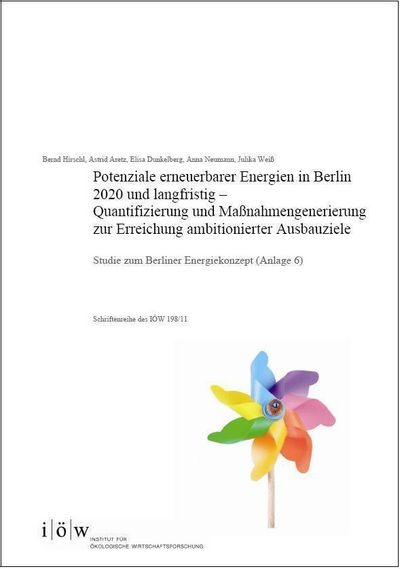Potentials of renewable energy sources in Berlin 2020 and in the long term - Quantification and generation of measures to reach ambitious expansion targets
The present study determines the potential of renewable energy (RE) in Berlin in 2020. It is part of the Berlin Energy Concept 2020, which was "noted with approval" and published on 5 April 2011 by the Berlin Senate. This detailed study was the basis for central data, context and policy recommendations which have in a concise manner been incorporated into in the long version of the energy concept (lead-managed by the Berlin Energy Agency).
To determine the potential for renewable energy in Berlin, a – in comparison to the existing database – more accurate and differentiated data set was generated for the year 2008, the base year for the scenarios. On this basis, potentials were determined for all relevant RE technologies. These include the various bioenergy technologies (small and large heat and power plants, biogas plants), solar heat and photovoltaic systems, wind, hydro and geothermal energy as well as heat pumps. In a first step, long-term technical potentials were determined before methodically differentiated exploitable potentials for the year 2020 were finally identified.
The results show that even Berlin – by far the largest German city – can achieve much higher shares of renewable energy in the long term in comparison to the current situation. Solar technologies in particular, but also heat pumps could make high contributions, supplemented by the (however limited) endogenous biomass potential. In particular, significant amounts of biomass and bioenergy will have to be imported. In 2020, accompanied by a set of suitable measures, Berlin could reach a total RE share of nearly 17% in the electricity sector and about 12% of the heat demand. Considering the possible biogas ratio in the natural gas network, the share of renewable energy in the heat sector would increase to over 15%. Although Berlin’s RE share would remain well below the national RE share, the growth rates would, however, still be considerable compared to the actual share of about 2%. The large-scale use of biomass, which is the main component of plans of the local energy provider Vattenfall, will make by far the largest contribution to electricity and heat generation from RE. But also decentralized biomass cogeneration will increase significantly. Concerning electricity generation, wind power follows with a share of about 3% and photovoltaics with a share of about 2%. Heat pumps could deliver approximately 2% of the heat demand in 2020 and solar thermal systems almost 1%. These shares, due to the low starting level, are not expected to rise significantly until after 2020.
The catalog of recommendations for measures to achieve those potentials predominantly comprises low investment measures, which should in particular enhance the diffusion of the respective technologies. It includes measures to increase knowledge, education and training, networking and demonstration activities, as well as the coordination and monitoring of the actions. The selective development of endogenous biomass potential, the support of private investment in the RE sector as well as the public operation of RE systems by the city of Berlin itself are addressed by the portfolio of recommendations. As Berlin is expected to import energy and energy resources from the urban hinterland, the development of biomass, wind and solar potentials in areas situated in Brandenburg but owned by the city of Berlin is recommended in conclusion.



